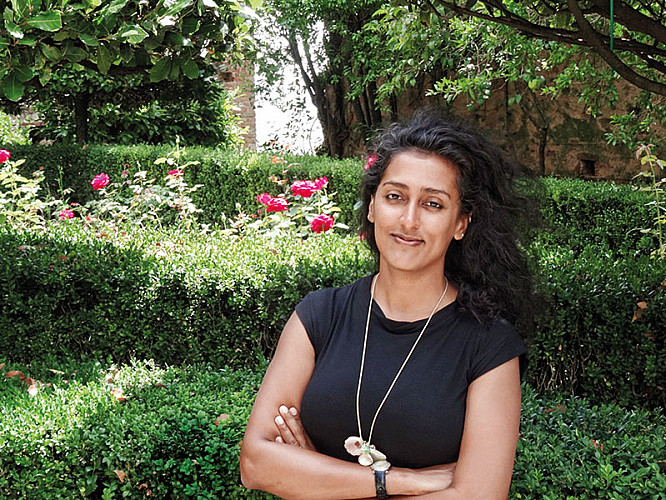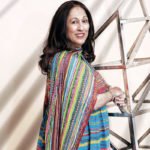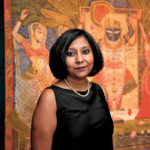Sandhini Poddar Talks About Curating Shows On Celebrated Indian Artists
Art history isn’t something that just happened to her. Sandhini Poddar’s mother, a professor of philosophy and aesthetics was instrumental in instilling an appreciation of art from a very young age. A childhood spent travelling around the world led her to New York and NYU — determined to work in the non-profit sector for a national museum. She has been associated with the Guggenheim since 2005, involved in special projects for its international museums. She has curated seminal shows on some of the most celebrated Indian artists of our time, such as Zarina Hashmi, V.S. Gaitonde and Bharti Kher (for the Rockbund Art Museum in Shanghai). But at the moment, her one-year-old baby is keeping her most busy!
“In 2006, the Guggenheim decided to embark on a very long term, large-scale project called the Asian Art Initiative, with the aim to really channelise and integrate modern and contemporary Asian art into all of the museum’s programming in terms of exhibitions, scholarships, conferences, acquisitions, publications. This is a project that is now 10 years old and up and running, and I was hired as one of the key people to develop it.”
“I really enjoy working on projects that have a long-term impact with the institutions and the public. All my works are seminal projects in collaboration with others and they all have their own huge impact. They form part of the museum collection. What I absolutely enjoyed were the programmes that I developed. The first was a creative commission by Anish Kapoor called Memory, which was a very complex, functional installation from both the technical and creative points of view. We developed it for the Guggenheim in Berlin and then it travelled to NYC.”
“The opening night of my first retrospective show in NYC — (V.S. Gaitonde: Painting as Process, Painting as Life, 2014-’15) — marked a personal achievement for me and of course for the Guggenheim too, and even for India as a country. That was a difficult exhibition to pull off, and many works were institutional collections from India — the Taj, the NGMA, the CSMVS, the TIFR. The fact that we were able to borrow so many pieces and put together a really cohesive body of work representative of the region, was great.”
“It’s imperative for artists to be amateur historians. You obviously can’t know all of art history, but you need to have an understanding of how human consciousness has evolved, how storytelling, oral history have been passed down from one generation to the next, how politics and the public shape cultures and who we are as a human race, at any given time. Most artists I’ve engaged with and who inspire me are very well read in terms of antiquity, in terms of current politics. It’s not about history, but who we are as citizens today and what’s happening around us. This also helps to develop one’s expression as an artist. It’s aspirational, and symbolic of our best capacities as human beings. It’s something that I fundamentally believe in.”
“I don’t follow individual artists. I’m much more interested in changing ideas about art and culture, and questions of philosophy. I’m not the kind of person who’s trying to showcase the next emerging artist, I’m more interested in movements, in questions like ‘Where are we at?’ and ‘How do we express ourselves?’ I think of ways to educate the public through works at the museum.”
“Art and technology both can tell stories. One of the aspects that has the potential to develop, and this is something that I feel, constantly, is the relationship between art and technology. It’s current. But it’s not new. How are we now going to transmit stories and appreciate art, sense culture in a way that we engage with virtual and augmented reality not as an end in itself but as a medium. So whether it’s paintings, works on paper, drawings, works on the computer…I think our engagement of new mediums of art, ways of creating them, the embodiment of art is constantly evolving.”
“A lot of spaces I like going to in India are not contemporary. I’m interested in the Buddhist caves at Karla in Mumbai, second-century carvings. I’m interested in the past, the unprecedented, stone architecture. That was also the development of technology at that time. Any kind of human expression — even cave paintings — speak to me on some level. For me, that’s a much bigger statement and achievement than something that belongs to the contemporary.”
“One of the earliest works I acquired for myself was this very beautiful charcoal work by Abanindranath Tagore. It’s kind of a miniature painting from the early 20th century, and shows three figures, with two of them crouching on a boat in the middle of the ocean. And it’s still one of my favourite works after 20 years of owning it, because I’ve always tried to imagine, what is the standing figure thinking about — the past, the future? I think it’s a beautiful metaphor.”
“I don’t think we should use the term ‘museum’ any more. I think that’s had its place. There’s a very interesting project called the Shed in Manhattan, that’s a multidisciplinary art space. It’s very malleable, it becomes small and large depending on the programming it inhabits — an exhibition, a performance, a show. It’s not the static idea of a ‘museum’, which is an ancient concept. The idea is more flexible, more interested in audiences, access to the public. It’s no longer hierarchical institutions. I think the Shed is a vision of the future.”
Related posts from Verve:
Verve Trending
Sorry. No data so far.
us on Facebook to stay updated with the latest trends






